Paper Doll
Moving? Here’s Your No-Stress Change of Address Checklist

ADVENTURES IN MOVING
A month ago, my best friend of almost forty years called me from her car. “Where are you?” I asked, expecting her to be somewhere en route between where she lives in New Jersey and somewhere near New York City. I was surprised to find out that she was in Central New York, headed toward Western New York (where I’m from), to look for a house to buy!
My BFF and her significant other had gone to a financial advisor to talk about the usual financial and tax planning topics as they approach a decade that will see many changes — from the last of the “kids” leaving home to their eventual retirements. Among his suggestions was to buy a home. While that wasn’t feasible in the very expensive area where they currently live, they contemplated moving closer to the areas where both had grown up.
Apparently, the housing market is pretty wacky right now. Home prices are up 30% from where they were just before the pandemic, a mere five years ago! Inventory is low, and demand is high. The morning I spoke to my friend, she’d had a list of six houses to look at the next day; by the time we chatted, three had already sold. Forty-eight hours later, they’d bought a (cute) house!

Photo by David Gonzales on Pexels (And no, that’s not my BFF’s house, but it’s cute.)
One of my other closest friends recently surprised me with a home announcement, too. He and his new spouse live in the south in separate cities; they’ve been working toward finding a city that worked for both of them as one can work remotely and the other was contemplating retirement.
This summer, while visiting a friend in the northeast, they decided to explore communities within driving distance, and unexpectedly found their “forever” home and, like my BFF, closed on a house quickly. Their move is happening as I write this!
As my area of expertise is paper, my initial concerns for both friends involved making sure they were registered to vote in time (per my advice in The Ultimate Guide to Organizing Yourself to Vote) and that they’d get their addresses changed so they’d be sure to get their mail and not miss any important notices or payments.
WHY YOU MIGHT CHANGE YOUR ADDRESS
Is mail that important? I mean, most of us get a lot less paper mail than we used to. Fewer people send cards and letters; people post their vacation photos on social media instead of sending postcards. Many folks take advantage of a one-time $5 credit if they get their utility bills by email (or have them auto-debited with email or text notifications after the fact).
Still, mail is can be vital, and making sure that your mail gets to you will make at least one aspect of the moving process less stressful. There are a few different kinds of address changes:
- Permanent changes of address for all concerned — This happens when you (and possibly your family or household members) change houses (or apartments) and leave (theoretically) for a different home.
- Permanent changes of address of address for only one member of a household, such as when one person moves out after a divorce, ostensibly never to return.
- Temporary, but long-term change of address for one person — Let’s say your kid is headed to college. If she’s staying in town and coming home every week to do her laundry and “borrow” the contents of your fridge, maybe no change of address is necessary. But if she’s headed across the state or country, she’ll want to change her address for most things until May, when she either moves back or tells you she’s going to bum around Europe to find herself.
- Temporary change of address for one person — There are various reasons for this option, but all involve being away from your home (for work or other obligations) for a length of time, with an expectation of returning.
Last November, Paper Mommy fell and broke her pelvis, then contracted pneumonia, and due to some medical neglect that makes me want to punch walls, had three hospitalizations and two stints in rehab over the course of two months.
My mother didn’t need to change her address to the hospital or rehab location — a family friend was able to collect her mail and bring it to her. But my sister, who relocated from her home state to my mom’s house for most of two months (and worked remotely while helping with my mom’s recovery), did redirect her mail, temporarily.
Similarly, I’ve had clients who have home bases but travel extensively and long-term for work. One relocates for six weeks out of every quarter to train different divisions of her company.
Another client is a “locum tenens,” a Latin word that refers to medical professionals (or sometimes clergy) who work temporarily in different locations. For example, travel nurses are temporary healthcare professionals who are hired to address staffing shortages, particularly when patient volume surges or there are higher seasonal demands. Assignments can range from four weeks to much longer, and 13-week assignments are not unusual. Nobody wants to be without their mail that long.
Some locums return to a home base between jobs; others move from one job to the next, living in temporary housing in each location. Getting mail wherever they are feels a bit more like home.
HOW TO CHANGE YOUR ADDRESS
Whatever your reason for changing your address, you’re going to want to organize your approach.
Get the details right
Do not pass go, do not collect $200. Before you submit your change off address for official notifications or share your new digs with friends, make sure you have the details exactly correct, including the full ZIP Code with extension.
I live in an apartment, and my address includes a street address (that applies to thousands of residents of many hundreds of apartments) as well as an apartment number, which is mine alone. Over the years I’ve been here, several new residents have mistakenly listed my apartment number as theirs, and I’ve gotten their mail and packages.

If the mail looks important, I’ve tried to find the person via social media and meet them in the parking lot to give them their mail; if it doesn’t seem vital, I usually write “no such addressee at this location” and return it to to the post office. But not everyone will do that, and you really don’t want to risk your mail or packages ending up with someone who isn’t as cool as Paper Doll.
- Verify your exact address with your real estate agent, landlord, or apartment complex management. You may need to start the change of address process before you get all your paperwork, so be sure to clarify via text or email to ensure it’s correct.
- Don’t make assumptions regarding the address based on what you’ve seen when visitinh. On Friends, Monica Gellar’s apartment’s fictional address 495 Grove Street; the building you see on the show is actually 90 Bedford Street, at the corner of Bedford and Grove in Manhattan. You’re not a TV character, but your home may have an address on one street even if the main (or only) entrance is on the cross street.
- Double-check to make sure that your new home is properly identified as Road, Court, Lane, Boulevard, Circle, etc. Many subdivisions have similar street names with only the final qualifier differentiating among them. (Want to go down a rabbit hole? Read What’s the Difference between an Ave, St, Ln, Dr, Way, Pa, Blvd, Etc.?)
A few months ago, I was on the phone with a friend who built a home in a new subdivision. He’d been delivered a package for a home with the same number as his on the next street over. He thought he’d do a good deed and walk the package over to them while we chatted. Unfortunately, the next street over was not numbered the same way, so the true recipient’s home wasn’t approximately behind his, but much farther away. Eventually, he cut through some backyards back to his house, got his car, and re-attempted the delivery. Again, not everyone is that helpful!
- Double-check the directional terms, like 129 West 81st Street (that’s Jerry Seinfeld’s place, in Apartment 5A). Make sure you ask for sound-alike numbers (five/nine, fifth/sixth) to be spelled out (in case you get Mr. Rogers’ old 4802 Fifth Avenue house).
- If you’re buying a recently-constructed home, triple-check. Sometimes, a developer may change the street names between when the plans were submitted to the post office and the municipality put up the street signs.
- Check to see if your street is actually registered with the post office. It’s hard to believe, but some developers sometimes forget this step.
![]()
This is fairly easy. Look up your address on the United States Postal Service ZIP Code Lookup site. Enter what you have of the address, and it should return the proper ZIP Code, including the four-digit extension.
You can enter the address to get other details, the city and state to figure out the ZIP code, or the ZIP code to determine the right name for your location. For example, my childhood home is considered in Buffalo, New York, but known by other names:
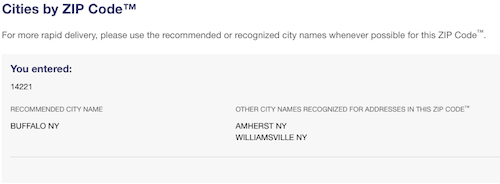
WHO NEEDS TO KNOW TO KNOW YOUR NEW ADDRESS?
Once you know to where you’re relocating, start spreading the news.
Start with the Post Office
Submit a change of address through the United States Postal Service. You can walk in to any post office and fill out a change of address form, or file a change of address online. (The USPS page also helps you change your address for the purposes of changing your voter registration address.)
Click to identify whether this is a change of address for an individual, family, or business. Provide your full name and email address (to which your confirmation will go); USPS also requires a mobile phone number in order to verify your identity and mitigate fraud.
Select whether you will be returning to your address within six months (to classify whether your change of address is considered temporary or permanent).
Choose the date when you wish mail forwarding to begin. (The minimum duration for a temporary change of address is 15 days. The initial forwarding period is restricted to 6 months, but can be extended up to 1 year.)
After you provide your old and new addresses, you’ll be charged the whopping fee of $1.10, by credit or debit card, for security purposes.
Standard mail forwarding lasts for a year. After that, you can pay for extended mail forwarding at the rate of $22.50 for six more months, $33.50 for an additional year, or $44.50 for eighteen months. At that point, you should have cycled through just about every annual bill and notification and should be able to notify everyone who might have slipped through the cracks in the year after your move.
Filing your change of address with the postal service will cover most of your incoming mail, but is only temporary.
The following should help get you on your way to recalling everyone else you need to notify.
Notify Government Agencies
Only you know which government agencies you deal with at the federal, state, and local levels, but start with these:

- The Internal Revenue Service — It should be obvious, but the IRS really needs to know where you live. It’s also to your advantage for them to be able to find you; you don’t want to miss out on refunds, rebate or stimulus checks, or important notices.
Fill out IRS Form 8822; learn more at the IRS Address Change page. Alternatively, you can submit your change of address on your next tax return, by phone, or by mailing a written statement that includes your full name, Social Security Number, and old and new addresses to the address to which you mailed your last return. (Yes, you probably filed online with Turbotax, but that’s what their instructions say. Use this IRS page to find a good mailing address.)
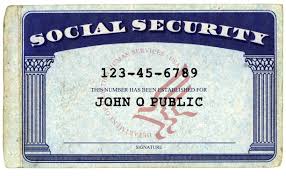
- Social Security Administration — If anyone in your household gets (or soon will receive) disability, retirement or survivor benefits and you live in any of the 50 states, DC, Puerto Rico, the U.S. Virgin Islands, Guam, the Northern Mariana Islands, or American Samoa, log into your account and use Social Security’s online system to change your address; you can also call 800-772-1213, Monday through Friday, 7 a.m. to 7 p.m. EST, but expect to provide information to prove your identity.
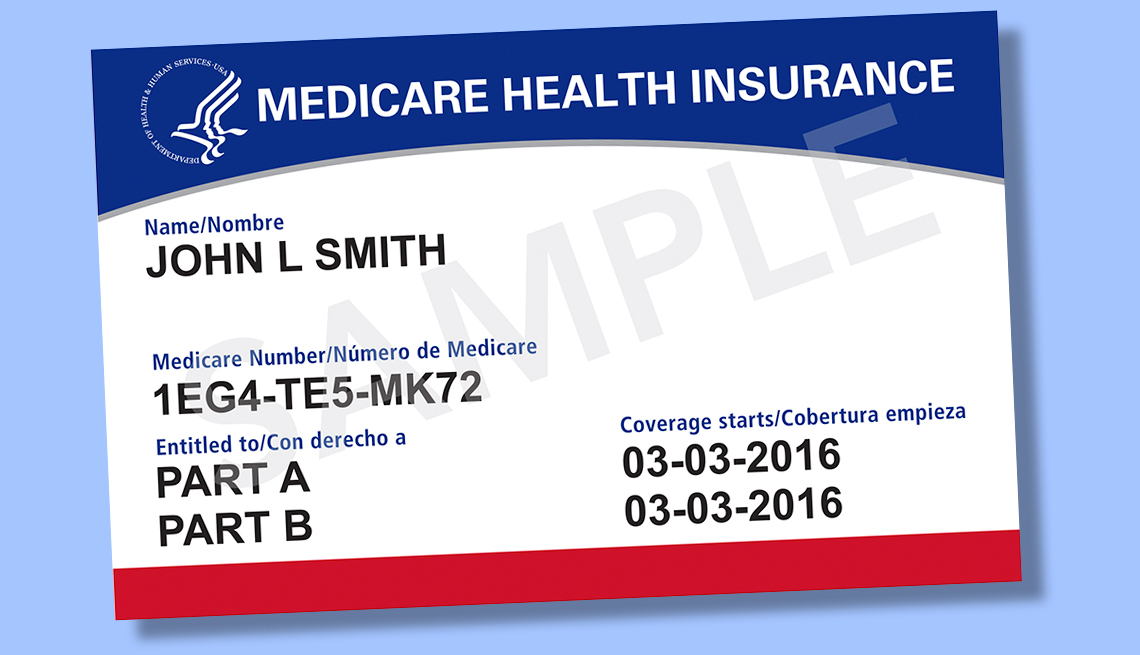
- Medicare — To change your address with Medicare, you must contact the Social Security Administration, as described above.
- Healthcare.gov — If you get your healthcare through the federal exchange rather than a state exchange or private insurance, log into your account and update your current application online. If you are moving within the same state, you can update your application online, by phone, or in person — but not by mail. However, if you move to a different state, changing your address is not enough; you will need to submit a new application and select new health insurance.
- Department of Veterans Affairs — If you or a member of your household has been in the military and receives military benefits (or will in the future), be sure to keep the address updated, either online in your VA.gov profile or use the Department of Veterans Affairs’ change of address printable form. Note that changing it in your online profile will speed the information across all divisions.
This is also important if you are the executor of a will or responsible for the estate of someone with military experience service. Make sure the VA can find you.
- U.S. Citizenship and Immigration Services — Most resident non-U.S. citizens need to report their changes of address within ten days of moving within the United States or U.S. territories; this should be done through your USCIS online account. If there’s a reason you can’t update your USCIS address online, you can download and fill out Form AR-11 to submit an Alien Change of Address Form.
Note that changing your address with the USPS will not change your address with USCIS and USPS will not forward your mail from USCIS, so you’ll want to jump on this.
- Voter Registration Offices — If you move, whether it’s across the street or to the other side of town, you need to update your address with your local board of elections. A change of address even within the same congressional district may still change your voting options for city or town council, school board, and other local issues.
If you move to a different county, city, or state, you’ll need to register to vote in that locale. As you learned in my post on voting, different states have different rules regarding the methods (in-person, by mail, online) for registering to vote and changing your address. You can also register to vote or change your registration information, including your address, via Vote.org.
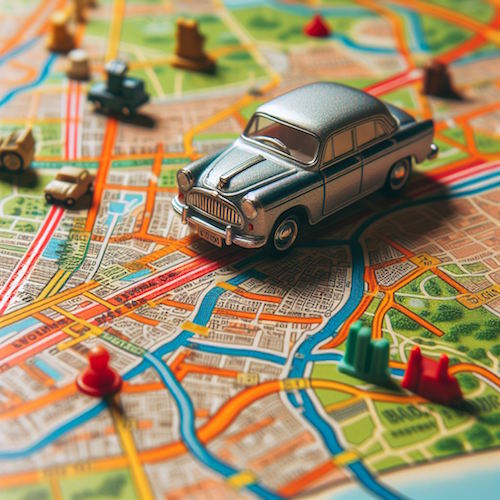
- Department of Motor Vehicles — Contact your state’s DMV to find their online change of address page (if you’re moving within the same state) or registration information (if you are changing states).
- Toll Pass Agencies — Don’t forget to update your address with whatever toll pass accounts you use. Look at your transponder if you’re not sure what agency handles your toll pass. EZ-Pass, for example, covers twelve states, and services I-PASS in Illinois, and other regional agencies in North Carolina, Indiana, Kentucky, and Florida.
- Unemployment Offices — Depending on your state, relocating while you receive unemployment benefits can be tricky. (If you move to a different state, your benefits will likely end.) Notify your state’s unemployment agency as soon as you being the moving process. In most states, the easiest way to update your address will be to log in to your state’s unemployment benefits online account. If you aren’t sure where to start, the Department of Labor has contact information for all state unemployment insurance offices.
Finally, if you are certified or licensed by your state to fly a plane or maneuver a boat, to fish or hunt, or to perform your profession, be sure to contact that government agency to update your address.
Contact Financial Institutions
Even if you conduct all of your financial transactions online, your providers need to know where you live because some financial rules and regulations are governed by the state in which in the accountholder resides. So, create a checklist for any and all of the following:
- Banks and credit unions where you hold accounts
- Brokerage houses and investment services, for retirement and non-retirement investments
- Credit reporting agencies — Officially, you only need to notify your creditors. However, it’s worth your effort to check Equifax, Experian, and TransUnion after the move to make sure your address has been properly updated. Log in to all three via AnnualCreditReport.com.

Little House Photo by Kostiantyn Li on Unsplash
- Insurance companies — Whether you have auto, homeowners, renters, health, or dental insurance, long-term care or life insurance, umbrella policies, or coverage for your business — if you’ve got insurance, notify them of your address change. In most cases, changing your address will change some aspect of your coverage, especially the cost.
- Lenders — Got credit cards? Auto or personal loans? (Obviously, if you’ve got a mortgage or a HELOC, those will be going away when you move, but the bank will still need to be able to contact you for a while.)
- Online financial accounts — Whether it’s Paypal, CashApp, Venmo, or Zelle, make sure your address is updated in the accounts. Where you reside impacts legal terms and conditions.
Tell the Boss Man (or Boss Lady)
You may not get a physical paycheck anymore, but your employer needs to know where to send tax forms and other official documents.
If you work remotely and change your state of residence, tell your HR department!
Notify Your Utility Companies
When you move, you (generally) don’t take your services with you, but you may keep the same account number. Notify the following when you change your address:
- Electric company
- Gas company
- Sewer service provider
- Trash/Waste/Recycling service providers
- Water company
- Internet service provider
- Telephone companies — You may not have a landline anymore, but you almost certainly have a phone. Be aware that the taxes you pay on cellular phone service are determined by the county in which your account is registered. If you use online billing, it may be to your advantage to keep your cell service registered to your old zip code, but your provider’s Terms and Conditions may not allow this.
- Television service provider — Sure, if you have cable or satellite service, that will change depending on where you move. However, the tax you’re charged for streaming services will change depending on the state to which you move.
- Other entertainment providers — Whether you subscribe to music or gaming services like Spotify or Twitch, or have tangible subscriptions for magazines and newspapers, update your address.
WHO ELSE NEEDS TO KNOW YOU’VE MOVED?
Notifying the above folks will keep you from getting into trouble or debt, but don’t forget all of the other individuals and companies that need to be able to find you.
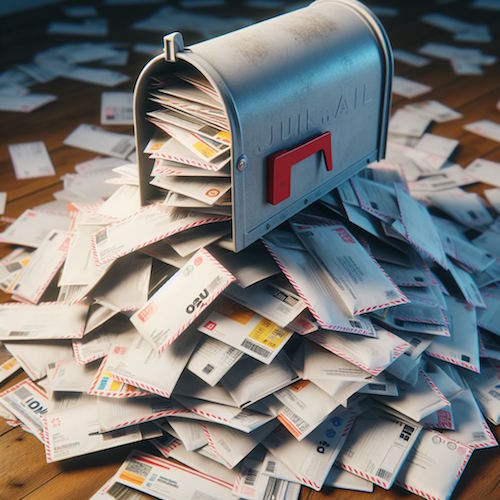
Household Services
Depending on where you move, your household service providers, whether a big company like Terminex or the nice lady who dusts your piano, will need to know how to contact you, whether to continue providing services or finalize paperwork. Start with these and brainstorm whom else you might need to contact:
- Alarm company
- Housekeepers
- Lawn and garden care
- Pest control
- Pool maintenance
- Snow plowing/shoveling
Healthcare Providers
- Internists/Family practitioners
- Pediatricians
- Specialists (OB/GYNs, ophthalmologists, endocrinologists, etc.)
- Dentists
- Orthodontists
- Veterinarians — If you have a pet with a microchip, update the chip’s registration to reflect your new address so Fido or Fluffy can be safely returned to you!
- Pharmacies, especially online pharmacies
Other Professionals
- Attorney
- Accountant
- Bookkeeper
- Financial advisor
- Personal coaches
- Professional organizer
Schools/Caregivers
- Daycare providers — for childcare, eldercare, or pet care
- School administrative offices — Every school needs your change of address: preschool, elementary, middle, and high schools as well as college, whether you are a student, parent or alumni.
- Tutors — Don’t be so busy with your move that your forget to tell your son’s algebra tutor or your daughter’s piccolo instructor that you moved. It’s no fun to stand at someone’s front door, ringing the bell and having nobody answer.
- Activity administrators — If your kids are in gymnastics or Tae Kwon Do, or you participate in any community organizations, make sure to update your address with them. Yes, the USPS mail forwarding will prompt you to remember this, but the sooner you update this information directly, the less chance there will be to miss something important.
Online Connections
Do you get meals from companies like Blue Apron or Hello Fresh? Make sure your food follows you to your new home.
Do you use food/shopping delivery services like Door Dash or Uber Eats? I’ve seen more than one tweet or TikTok video with someone ordering delivery for the first time in a long time and only realizing after they ordered that the delivery was going to the city where they used to live. (It’s universally agreed that when that happens, you tell the driver to keep the meal and enjoy it!)
Be sure to update your address at Amazon and other retailers where you shop online. Got an Amazon (or other) wish list? Change that address too, or your friends will be upset when they send you birthday presents that you don’t get!
Do you travel? Update your addresses for your hotel, airline and other frequent-user accounts
Tell Your Peeps
You’re not going to forget to give your mom your new address, but remember to update your friends and members of your personal circle, including:
- Extended family and friends — The upside is that you may get sent a housewarming present!
- Civic organizations and clubs to which you belong
- Houses of worship and religious organizations
Business Contacts
I could write an entire post about whom your business should contact regarding a changed address. But for personal mail regarding your professional life, consider:
- Professional associations
- Licensing and certification boards
- Formal networking groups
- Affiliate programs from which you are expecting commissions
All of the above assumes that you’ve moved house in the United States. If you move to another nation, be sure to register your address with the U.S. embassy or consulate in your new country. This will ensure that you receive essential updates about safety, security, and emergencies in your area.
Paper Doll Explores the Best of Desktop File Boxes

September always gets me thinking about school supplies, and office supplies are really just school supplies for grownups (and for all of us pretending to be grownups).
So, when an editor friend (now at Yahoo! Life), contacted me for a few organizing-related pieces, and asked me what my favorite under-$20 organizing item was, I immediately knew that I was going to pick something related to paper. (I mean, come on, I’m Paper Doll!)
See Your Way Clear: Organize With Transparent Sticky Notes

Longtime Paper Doll readers know that I’ve had a complex relationship with sticky notes. On the one hand, in the very first month of this blog, all the way back in 2007, I railed against writing things on random pieces of loose paper in Stay Far From Floozies: Avoiding the Loose Paper Trap.
On the other hand, over the years I’ve broadened my approach. It’s not the sticky notes, per se, personified by 3M’s Post-it® Notes, that left me chagrined, but the act of writing things you want to remember on any visible piece of paper, without rhyme, reason, or organizational process. To that end, I’ve shared a wide variety of pro-sticky note posts, including:
- Organizing With Post-it® Notes: Revenge of the Floozies — Three years after coining the expression “floozies” for loose paper and casting aspersions on sticky notes, I praised the ways you could effectively use sticky notes to keep yourself organized in the office, in dorm rooms and when studying, financially, and when planning projects.
- Sticky to the Extreme: Organizing Information in Extreme Situations with Post-it® Extreme Notes — These super-powered stickies handle the extreme conditions of heat, cold, humidity while preserving powerful delivery of the message.
- Paper Doll Adds a Pop of Color with Bright & Sunny Office Supplies offered up a colorful review of the Post-it’s ten different themed families of note hues for brightening your work day.
- Paper Doll Shares 3 Quirky & Cool New Office Supplies looked at the niftiness of lined sticky notes (and devices for neatly making bullets and lines on them)
- Emerson, Angelou, Ted Lasso, Tashlich & Zen Monks: Letting Go for a Fresh Start was ostensibly about new perspectives and giving yourself a new beginning, but it also introduced 3M’s super-nifty Super Sticky Big Notes, 11″ x 11″ and 15″ x 15″ sticky notes.
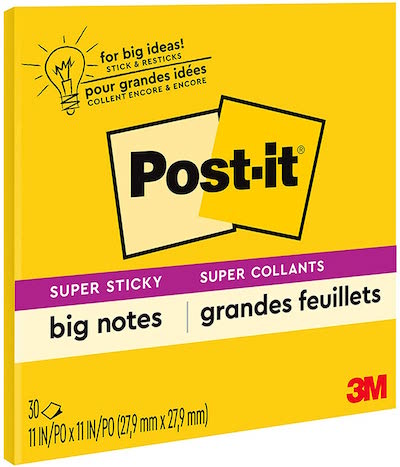
- Paper Doll Helps You Find Your Ideal Analog Habit Tracker — They may look like they’re just tiny scraps of paper, but both traditional sticky notes and specialty items (mini-lists, planners, and habit-trackers) in the Noted by Post-it® line offer cheery solutions for keeping your life organized. We looked at an expanded view of some of the Noted products in In Search of Lost Time: Productivity, Proust, and the Culture of Availability.
So, let me be perfectly clear: stickies have have a place in organizing — as long as they’re used intentionally, mindfully, and not randomly.
With all this in mind, today’s Paper Doll post explores another intriguing sticky note option reminiscent of the novelty we discussed back in 2012 when I looked a different transparent office supply solution, in Paper Doll Rolls the Highlight Reel: Removable Highlighter Tape.
BENEFITS AND USES OF TRANSPARENT STICKY NOTES
When it comes to organizing thoughts and information, I want the benefits of transparent sticky notes to crystal clear.
In case you’ve never seen a transparent sticky note, think of it as combining the functions of tracing paper and sticky notes.
Transparent sticky notes — which, to be fair, I generally more translucent or slightly “frosted” than entirely transparent — offer several benefits that distinguish them from traditional opaque ones, especially for organizing and annotating. Additionally, the notes (though not the writing) are waterproof and are generally more durable than traditional sticky notes.
Having trouble envisioning how they work? Take a peek:
Academic Uses
Transparent sticky notes are ideal for students at all levels, but particularly in high school and college, especially when studying texts where annotations are helpful or even necessary but the page or document must not be permanently altered.
Transparent sticky notes allow students to scribble questions, ideas, connections, and thoughts directly over content. The notes can be applied, easily removed or repositioned, and (if carefully stored) applied again later.
- Overlay Text or Drawings Without Obscuring What’s Beneath
Transparent sticky notes allow you to place and affix notes directly over text or diagrams without covering the printed content.
This is particularly useful for annotating books and textbooks, source documents, or presentations where you want to preserve visibility of the original material.
Science textbooks often include complex illustrations of plants, processes, or anatomical design. Students can learn a few elements at a time, add explanatory text to the overlaid sticky notes, remove the note to test themselves, and create new ones for different elements.
- Highlight and Emphasize Information
By placing a transparent sticky note over a portion of text or an image, you can use a highlighter or writing implement to highlight, annotate, or draw attention to specific details without making permanent marks on the original material.

You can use a highlighter directly on a clear transparent sticky note; tinted translucent notes let you both color code concepts or categories and serve the same accenting purpose as a traditional highlighter.
Teachers can write comments pointing to specific areas of a student’s work while not damaging the masterwork, and tutors can add explanatory guidance to notes and then remove them when coaching students to remember what was on them.
Students using printed textbooks can highlight or annotate content, remove and re-affix the notes for studying and self-testing, and then re-sell the practically pristine textbook to the college bookstore after the final exam! (Yes, I know college students primarily use digital textbooks now, but they still read many novels and auxiliary books and use workbooks in traditional formats.)
- Copy content to paste into notes
Remember how I said that transparent sticky notes work like a combination of a traditional sticky note and tracing paper? Trace directly from your text book and then affix what you’ve traced into your handwritten notes.
The hand-brain connection means that students will remember the material much better from the experience of hand-tracing than they might if they only photocopied an illustration or chart.
Organizational Uses
This is an organizing blog, after all, so we should look at the organizing advantages.
- Layer for Enhanced Organization
You can layer transparent sticky notes on top of one another or over documents without losing sight of the information underneath. This can be useful in complex planning, when you want to group ideas visually without obscuring the main content.
Again, students can use layering for studying illustrations or maps, adding their notes and layering different types of content on top of the original material, with layer upon layer adding more nuance and detailed information. (I’m reminded of my 9th grade Social Studies class where, when faced with a blank mimeographed map of Africa, we had to learn (and later fill in on subsequent weeks), the country names, then the capitals, then the colonial influences, and the top exported product. I could have really used transparent notes, but regular Post-it® Notes hadn’t made it to our school supplies yet!)
- Reorganize Ideas Easily
One of the great benefits of traditional sticky notes is that you can move them around, but again, transparent/translucent sticky notes augment that benefit. They allow for more flexible, real-time organization of thoughts, whether they’re used on a document or handout, the page of a textbook or workbook, or even on a large-format item like a map, poster, or whiteboard.
Improve Every Stage of a Project
When you work (or study) in a creative field, your work often has many iterations. Having an overlay for things that aren’t (yet) perfect gives you flexibility to be creative without fear of losing a creative draft or burst of genius.
- Clear the Way for Creative Work
Transparent sticky notes can help for artists, designers, and creators who need to annotate their thoughts without hiding underlying sketches or design elements. Create temporary markups and adjustments without altering the original work.
Musicians might create an overlay with the conductor’s suggestions written on an angle, above or below the measures, bars, and notes.
- Collaborate and Brainstorm
In collaborative environments — picture a Mad Men-style creative team or a garage band figuring out how different instruments and vocals might come together — transparent sticky notes enable participants to add thoughts or ideas on top of shared content, whether on a design, blueprint, or lyric sheet.
The ability to make changes without altering the original fosters more flexible brainstorming sessions without fear of losing track of the original document or a sequence or flow of ideas.
Who else might use transparent sticky notes?
The unique properties make transparent sticky notes a versatile option in various context. In addition to traditional students and teachers in an academic setting, who else might use these notes?
- Authors — Most authors now edit galley copies of their books digitally, directly in PDF files. However, editing that way isn’t always comfortable. Writers might choose to make notes (on clean copies of their galleys or even printed drafts) and then highlight changes on transparent stickies.
- Memoirists — Reading your own handwritten journals to help document the history of your thoughts and actions? You probably don’t want your 2024 handwritten notes directly on the pages of your circa-1981 Snoopy diary, but overlaying transparent sticky notes helps the you in the present engage with the you of the past.
- Researchers — When faced with a variety of primary sources that can’t be doodled upon (or when you don’t have access to a copy machine but would prefer to handwrite your notes layered over a document), a transparent note can help you make a deeper connection between your thoughts and the original work than taking notes on a computer or pad of paper.
- Book reviewers — Whether you review books professionally or just for Amazon or Goodreads, it’s helpful to have your contemporaneous thoughts while reading and your highlighted quotes at the ready. If you find marking up books to be almost sacrilegious, transparent stickies are a great option.
- Cooks — Some people take recipes in cookbooks as gospel; others like to “doctor” things up. If you were experimenting as you went, you might not want each changed variable to be written onto the original recipe, but you’d still want to track the changes you made until (or even after) you achieved delicious perfection. TheKitchn blog post This Mind-Blowing BookTok Trend Will Change the Way You Use Your Cookbooks is a bit hyperbolic but does show the use case in action.
- Attorneys — Boilerplate contracts are in computers, and paralegals make the revisions digitally as instructed. But most lawyers can be seen reviewing photocopies of contracts and mocking them up with revisions. Transparent sticky notes would let them see the original contract language, highlight relevant passages, and make revisions; similarly, they might use transparent notes to help them accent points in transcribed depositions and testimony they want to refer to in court.
- Spiritual adherents — Whether you participate in some kind of formal Bible study or just like reading holy texts from any of a variety of comparative religions, you probably don’t want to scribble your thoughts in the (or any) “Good Book.” Use transparent sticky notes to highlight and annotate questions, feelings, or motivational elements.
- Crafters — Whether you’re trying to map colors for a needlepoint project or adjust the measurements on a pattern, writing directly on the instructions or designs can get messy, especially if you need to revise your notes. A transparent overlay lets you adjust without the mess.
How might you use a transparent or translucent sticky note?
CHALLENGES PRESENTED BY TRANSPARENT STICKY NOTES
While transparent sticky notes offer many benefits, they do have some downsides to consider.
Potential for Residue
Some brands of transparent sticky notes might leave a slight residue, especially if left on delicate surfaces for an extended period. (Bibles and textbooks from before the1950s tend to have pages that are as thin as tissue paper.)
Obviously, this varies depending on the quality of the adhesive used, and higher-end (and honestly, brand-name) versions will typically avoid this problem. If the book or document you’re using is delicate, test it on a back page, like in the glossary or index.
Adhesive Strength
Transparent sticky notes may not be adhere as strongly as traditional opaque sticky notes, particularly on rougher surfaces. Unlike the recycled paper of traditional sticky notes, the slightly slick material used to make transparent sticky notes makes the notes more durable but the adhesive may be less durable. This means they might peel off more easily, especially on surfaces that aren’t perfectly smooth or when the notes are repositioned (or applied, removed, and re-applied) multiple times. Again, test them.
Writing Challenges
Depending on the material, certain pens and markers may not write as well on transparent sticky notes. This can limit their functionality (compared to traditional paper-based sticky notes) if you (like Paper Doll) prefer one specific type of pen. Again, brand-name versions are likely to allow a greater variety of pen use; Post-it® shows multiple examples of workable writing implements.

Less Absorbent Surface
Unlike paper sticky notes, which easily absorb ink, transparent sticky notes are usually made from plasticky or filmy material, like stiff, glossy tracing paper. This can cause ink to smear or take longer to dry.
Most of the TikTok videos I found on the topic are in agreement that mechanical pencils, ball-point pens, and markers work best, and that water-based highlighters and pens are the least effective. If you use markers or gel pens, especially if you also intend to highlight what you’ve written, be sure to let the ink dry thoroughly before touching or highlighting.
Limited Color Options
While some transparent sticky notes come in pastels and neons, they usually lack the range of vibrant colors available with opaque sticky notes, especially the myriad Post-it® colors. This can limit your ability to color-code effectively when organizing ideas. You can easily find colorful options, but perhaps not your preferred color schemes.
Glare and Reflection
Due to their transparent nature, this kind of sticky note may glare under certain lighting conditions, making them more difficult to read or see clearly in brighter environments or on glossy surfaces.
Cost
Transparent sticky notes, whether brand name Post-it® versions or generic, tend to be slightly more expensive than their opaque counterparts, so if you’re on a budget or need a lot of them, the cost could be a drawback.
If you’re using these sticky notes for creative, academic, or professional purposes where clear visibility is key, these downsides may be manageable. However, for heavy-duty or everyday use, traditional sticky notes are usually going to be more practical.
VARIETIES OF TRANSPARENT STICKY NOTES
According to the website, Post-it® Transparent Notes come in 7 varieties, all with 36 notes per pad (though I was able to find an additional 10-pack of the clear version at Staples.com for a whopping $26.46)!
- original transparent (clear) pad ($7.29 at Staples.com or $5.35 at OfficeSupply.com)
- a two-pack with one original clear pad and one blue pad
- a three-pack assortment (pink, orange, and green) pads ($12.59 at Quill)
- a five-pack assortment (purple, orange, pink, blue, and green)
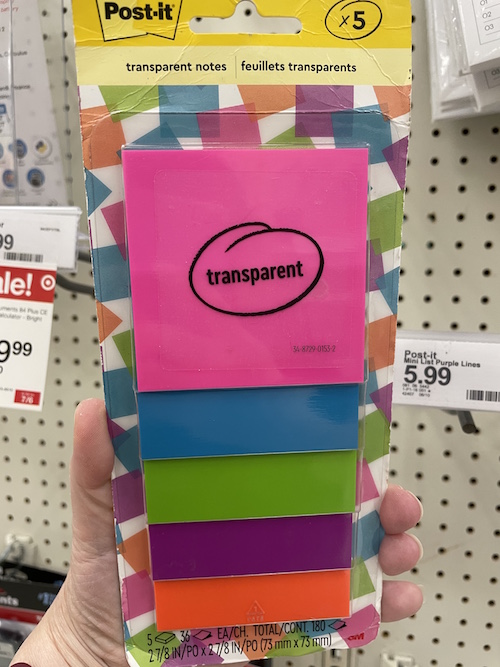
- an eight-pack with four clear pads and one pad each of orange, pink, blue, and green
- an eight-pack with two pads each in blue, pink, green, and orange ($14.99 at Amazon)
The Ultimate Guide to Organizing Yourself to Vote
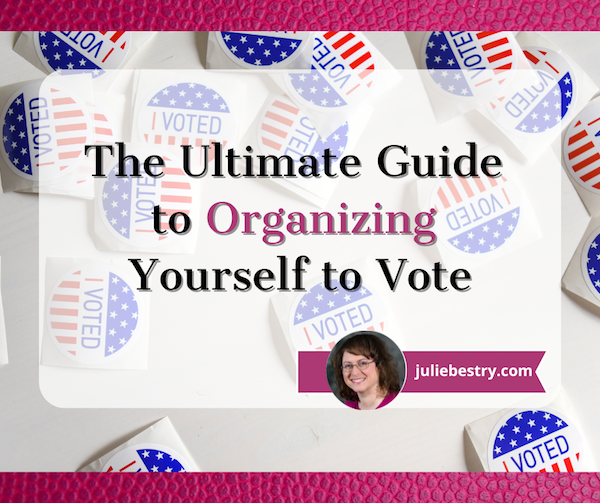 WHAT DOES VOTING HAVE TO DO WITH ORGANIZING?
WHAT DOES VOTING HAVE TO DO WITH ORGANIZING?
The word organize has three common meanings:
- to arrange, assemble, or put in order your tangible stuff (or activities or thoughts) so you can access what you need when you want it, to be more productive
- to coordinate, assemble, and unify a group, as when organizing a search party for a missing child or organizing in a union to collectively bargain
- to mobilize in support of a cause or effort you value, like Save the Seals (remember that, GenX?) or “Fix the Pot Hole on Main Street!”, or to get a candidate elected or a ballot proposition approved or rejected
In the United States, National Voter Registration Day is September 17, 2024, and no matter what you believe regarding any given issue or candidate, it’s hard to make a difference if your resources and information are disorganized.
To that end, today’s non-partisan post includes everything you need to know to exercise your right to vote, no matter your opinion on candidates, propositions, or pot holes.
(Dear non-US readers; please feel free to post non-partisan links about organizing to vote in your countries in the comment section.)
KNOW YOUR “WHY”
We do not have government by the majority. We have government by the majority who participate.
~ Thomas Jefferson
No matter which candidates get your vote or what positions you take on any given issue, don’t let disorganization to be an obstacle to voting.
If you’re an American citizen over the age of 18, you have the right to cast votes regarding a wide variety of national issues and policies, including:
- The Economy
- The Environment and Energy policy
- Foreign policy
- Healthcare
- Immigration
- Reproductive and Family Issues
- Veterans’ Affairs
It’s not just federal policies and candidates. You never know when you’ll care about a school board vote that impacts your kids, a zoning issue, or a noise ordinance related to a neighbor’s teenage beau boosting Peter Gabriel’s In Your Eyes at maximum decibels in the wee hours.
Voting preserves your right to have a say in how your community (school district, town, city, state, and nation) will be governed. It also allows you to model community organization and civic responsibility for your children or grandchildren.
REGISTER TO VOTE
Let’s start with the basics of voter registration.
Know your state’s voting eligibility requirements.
You would think voting eligibility requirements would be uniform across all fifty states, but nope. (Note: residents of the United States’ territories can vote in presidential primaries, but not the presidential election, nor in Congressional or Senate races.)
Between 1812 and 1860, property ownership qualifications to vote were progressively abolished. In 1870, non-white men gained the right to vote. Until the 19th Amendment, ratified in 1920, only twenty states granted women the right to vote.
Even then, in effect, only white women were guaranteed suffrage, as poll taxes and civic literacy tests disenfranchised the poor and people of color. (Poll taxes were stuck down by the 24th Amendment; the Voting Rights Act of 1965 outlawed discriminatory state voting practices.)
Native Americans weren’t granted the right to vote until 1924, and that right wasn’t guaranteed until 1948. And of course, the 26th Amendment lowered the minimum voting age requirement from 21 to 18 in 1971, when Paper Doll was only four years old, but already really wanted to vote.
Federal voting regulations aside, individual states have varying rules regarding voter eligibility. In order to vote in federal and state elections, you must be a citizen, of “sound mind,” and over the age of 18, but most states have residency requirements.
In 1972, the U.S. Supreme Court struck down one-year residency requirements, ruling that anything in excess of 30 to 50 days violated equal protection of the Fourteenth Amendment.
And given that residency implies an address, the passage of the National Voter Registration Act of 1993 and 2002’s Help America Vote Act — in addition to modernizing voting technology — removed registration impediments and ruled unhoused people may not be denied the right to vote based on their lack of a permanent address.
Thirteen states (Alaska, Connecticut, Delaware, Florida, Georgia, Idaho, Montana, New Jersey, Utah, Vermont, West Virginia, Wisconsin, and Wyoming) and Puerto Rico do not require a mailing address, and in Arizona and Nebraska, homeless citizens may use county clerks’ offices and court houses as their mailing addresses.
Most states have regulations restricting the voting eligibility of convicted felons while in prison or on parole, while convicted felons in Kentucky and Virginia lose the right to vote in perpetuity. (Florida recently reversed its law in this regard, but … it’s complicated.)
Know your state’s voter registration deadline
As befits a nation that initially considered itself to be a collection of smaller nations, each state has its own voter registration deadlines.
Twenty-two states require registration between 16 and 30 days prior to Election Day (Tuesday, November 5th this year). Six states require registration from 1 to 15 days prior to election day, and twenty-two states and Washington, DC allow registration at your polling place on Election Day.
Fill out the “paperwork” to register to vote.
Your paperwork may not be on paper; forty-three states (plus DC and Guam) allow online voter registration, up from only fourteen in 2008 when I first wrote about organizing to vote. However, you must register to vote by mail or in person in Arkansas, Mississippi, Montana, New Hampshire, South Dakota, Texas, and Wyoming.
Notably, North Dakota does not require voters to register, having abolished advanced registration in 1951! As long as you’ve lived in the state for 30 days and have valid ID, you can vote.
To register:
- Check online, call, or drop by your Board of Elections to request a registration application.
- The National Voter Registration Act of 1993, also called the Motor Voter Act, made it possible to register when you apply for or renew a driver’s license or at government agencies when applying for public assistance and disability.
- Find your state election offices at USA.gov, or Google “board of elections” or “election commission” and your county name plus the state (because there are 31 Washington Counties, 26 Jefferson Counties, and 25 Franklin Counties).
- Use the master voter registration document at Vote.org, or scroll down on that page to find your state’s voter registration site.
Review your voter registration card and keep it safe
Voter registration cards show your voting precinct (which determines where you vote) and districts (e.g., Congressional, State Senate and House, school district, county/city district, etc.) for individual campaigns, referenda, and ballot initiatives.
File your card with your VIP papers, and make a notation on your calendar to bring your card to the polls on Election Day (or on early voting days, if applicable). You may only need your photo ID, but I recommend always taking your voter registration card with you to vote, especially if you registered recently.
SPECIAL CIRCUMSTANCES FOR REGISTERING AND VOTING
If you or someone you know needs assistance with registering to vote and securing a ballot, check the following resources.
College Students
Students should determine whether they will register to vote in their home states or at school. They are likely to be first-time voters and unfamiliar with residency requirements, party registration, absentee ballots, and the election process. These resources will help.
- Away at College: Where Do You Vote? (FindLaw)
- How to Vote in College: Know Your Rights (BestColleges)
- Out of State College Student Voting Guide (All-In Challenge)
- Voting as a College Student (Vote.org)
Disabled Voters
- The Americans with Disabilities Act and Other Federal Laws Protecting the Rights of Voters with Disabilities (ADA.gov)
- Resources for Voters with Disabilities (US Election Assistance Commission)
- Voters with Disabilities Activated (National Disabilities Rights Network)
- Voting with a Disability (Vote.gov)
- Voting Accessibility (US Election Assistance Commission)
Members of the US Military
- Military and Overseas Voters UOCAVA (US Election Assistance Commission)
- Military Voters (Federal Voting Assistance Program)
- Voting During Military Service (FindLaw)
- Voting While You’re Away From Home: The Absentee Voting Process (Military One Source)
Overseas and Expat Voters
Are you an American citizen reading Paper Doll from somewhere outside of the U.S.? Howdy! These non-partisan sites can help you register and vote from abroad:
- Election Assistance Commission
- Federal Voting Assistance Program
- Overseas Vote Foundation
- Vote from Abroad
Unhoused voters
- Every One Votes (National Alliances to End Homelessness) — including A Toolkit to Ensure People Experiencing Homelessness Can Exercise Their Right To Vote
- The Homeless Vote: Can You Legally Cast a Ballot? (FindLaw)
- Step-by-Step Voting Guide for People Experiencing Homelessness (United States Interagency Council on Homelessness)
- Voting for People with Nontraditional Residences (The National Conference of State Legislatures)
- You Don’t Need a Home to Vote (The National Coalition on the Homeless ) includes a voter information primer and a 2024 voting rights manual
CHECK YOUR VOTER REGISTRATION
Perhaps you registered to vote years or decades ago. Even if you wore an “I Like Ike” button, registering to vote once is not enough. Even after you register, there are multiple ways you can fall off the rolls, as Archie Bunker learned years ago!
If you haven’t voted in several election cycles — whether presidential or mid-term elections — your state may remove you from the rolls.
If you move, even within a state, you have to register in your new location. Update your registration even if you move neighborhoods in the same town, as dividing lines for school and legislative districts are narrowly drawn.
You may be purged from the rolls by accident, such as if you share a name with someone who died, or intentionally as part of partisan disenfranchisement efforts.
Check your voter registration soon, before the deadline for registering in your locale, to ensure that you are able to vote on election day. Contact your local board of elections, or go to https://www.vote.org/am-i-registered-to-vote/ to use the state-by-state lookup.
LOCATE YOUR POLLING PLACE
Your voter registration card should specify your polling place. Alternatively, many boards of elections or election commissions let you safely log in to your registration with information like your name, birthdate, and part of your Social Security number (which they already have on record).
Or, use Vote.org’s Polling Place Locator.
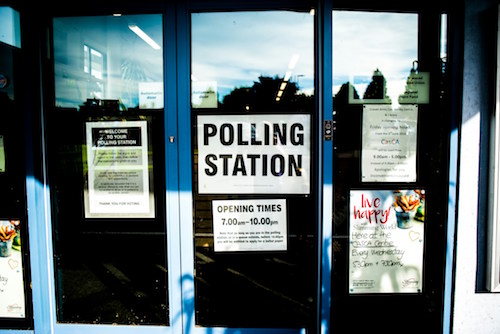
Photo by Elliott Stallion on Unsplash
If you have early voting in your jurisdiction, it may be at a different polling place than the one listed on your registration card. My Election Day polling place is within walking distance of my home; however, to avoid inclement weather or having to rush on a client day, I vote at one of the four early voting locations in my city.
OR, ARRANGE TO VOTE BY MAIL
Voting by mail has become more popular, particularly since COVID, but as with other voting regulations, the rules vary by state. This method, usually referred to as an absentee ballot, reduces crowding at the polls, increases voter participation, and makes it easier for college students, people with disabilities, members of the armed services, travelers, and others to cast their votes.
In eight states (California, Colorado, Hawaii, Nevada, Oregon, Utah, Vermont, and Washington) and the District of Columbia every eligible voter can vote by mail. (And in Colorado and Oregon, all eligible voters are mailed a ballot without even having to request one.)
Voters in those eight states and DC can generally return ballots through the USPS, in-person at election offices, or in secure drop-boxes. In states that have in-person voting, voters may still opt to vote at the polling place.
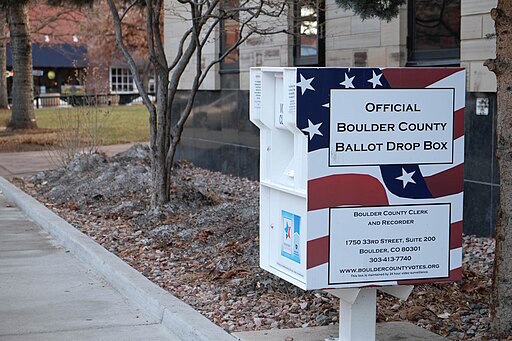
Paul Sableman, CC BY 2.0, via Wikimedia Commons
But what if you live in the 42 states and 14 territories that don’t run all elections by mail? There, eligible voters must request a ballot.
Some have a “no-excuse” ballot system; request a ballot for any reason. Other states require you submit a “valid excuse,” which might be that you will be out of state for business or out of the country due to work or military service, that you will be hospitalized or otherwise too infirm to vote; some states let everyone over 65 vote by mail.
The duration of absentee ballot status can vary. In some states, like New York or Georgia, once you request an absentee ballot, you’ll receive one for all elections, whether federal, state, or local, general elections or primaries. In others, voters must request absentee ballots for every single election in which they intend to vote.
Scroll down on this FindLaw page for a comprehensive list of each state’s requirement for requesting an absentee ballot and voting by mail. Where applicable, it provides a link to each state’s absentee ballot application.
Make sure you’re registered to vote by the applicable deadline, then contact your county’s Board of Elections or your state’s Secretary of State for an absentee ballot.
SECURE THE RIGHT IDENTIFICATION
Your voter registration card proves you registered (at some point) but it can’t be used as ID to vote.
If you live somewhere like Dixville Notch, a tiny New Hampshire polling district of four registered voters, the poll worker is likely your daughter-in-law or third grade teacher who knows you. However, most jurisdictions require you to show some kind of government photo ID, like a driver’s license, state-issued ID card, military or tribal ID, or a passport, and even locations without strict voter ID laws require first-time voters who’ve registered online or by mail to show ID.

Other states accept non-photo identification with proof of name and address. For example, in Arizona you can bring your Indian Census card; in Kansas, government-issued concealed carry handgun or weapon licenses and government-issued public assistance ID cards are acceptable ID; Virginia allows valid student IDs.
Even states that are strict regarding photo ID have exemptions, such as for those with a religious objection to being photographed, or have impediments to getting an ID (due to indigence or after a natural disaster). Wisconsin has confidential voting for victims of domestic abuse, sexual assault, or stalking.
Check your state’s voter ID laws at your board of elections website or this list from the National Conference of State Legislatures.
Alternatively, use the map at VoterRiders.org and the cursor over your state to see what proof of identification your state requires. States are divided by strict and non-strict photo ID laws, strict and non-strict non-photo ID laws, and states with no specific ID required.
If you have none of the appropriate categories of identification required by your state, you’ll want to get a state-issued photo ID card. In most cases, this will require presenting a copy of your birth certificate, as explained in How to Replace and Organize 7 Essential Government Documents.
All this aside, if you don’t have your ID, you can generally cast a provisional ballot by signing an affidavit, signing a poll book, and providing biographical information. (You may also cast a provisional ballot if your identity or right to vote is challenged by a poll worker or election official, or if your name is not on the poll or registration list on Election Day.)
MAKE A PLAN FOR WHEN AND HOW YOU WILL VOTE
Very little gets done unless you organize your schedule to do it.
Think of voting the way you might think of leaving on a trip. Normally, you might get in your car, drive to the airport, park, and fly. Or perhaps you arrange to have a friend drive you. But if you wait until the last minute and you have a dead battery or flat tire, or your friend’s child has the flu but no baby sitter, you’d have to scramble to figure out whether you’d call another friend, get a rideshare, or find some other solution.
Voting is not time-specific, but it’s day-specific, and the lines in some precincts can be as long as those for TSA. And if you were planning to vote after work, but you got delayed by weather or traffic, you might be cutting it close.
When and how will you vote?
Look at your schedule and figure out:
- Will you vote by mail? How will you remember to get your ballot in the mail or to a drop-box by deadline?
- Will you vote early? What day? How will you accommodate your schedule and remind yourself to go? At which early voting polling place can you vote?
- If you’re voting on Election Day, what time will you go and how will you get there?
Borrow some accountability and vote with a friend. Arrange to vote together (early or on Election Day) or even drop your mail-in votes at a drop-box together, then celebrate your right to vote with an ice cream, adult beverage, or meal.
How will you get to the polls?
If you’re going to the polls in person, either on Election Day or when voting early, plan how you’ll get there, and create a backup plan in case something goes awry.
If you are able, offer rides to those who may lack transportation or the physical ability to get to the polls on their own.
If you need help getting to the polls:
- Ask friends or neighbors how they are voting and see if you can ride with them.
- Ask if your house of worship is transporting congregants to the polls for early voting.
- Get free rides to vote early via Lime, as well as access to free scooters and e-bikes through Vote Early Day.
- Check to see if your locality offers free public transportation via bus or rail on Election Day.
- Call your public library or your state’s League of Women Voters to find out what assistance is available locally to help voters get to the polls.
- Ride Lyft, partnering with Levi Strauss & Co. and Showtime/MTV, to providing discounted rides to the polls.
RESEARCH THE BALLOT
Democracy cannot succeed unless those who express their choice are prepared to choose wisely. The real safeguard of democracy, therefore, is education.
~Franklin D. Roosevelt
You may be able to log into your board of elections or election commission site to see a sample ballot prior to any local, primary, or general election. Alternatively, use:
- League of Women Voters‘ Vote 411 — Provide your state to get your voting information. Closer to the election, click on the Candidate and Ballot Measure Information tab.
- LWW’s 411 also offers a personalized ballot — Enter your address and view (or print) ballot guidance.
- Ballotpedia is a digital encyclopedia of elections. Pick federal, state, and local elections, as well as ballot measures, from the sidebar to aid your research, or look up your sample ballot.
- Vote.org has a See What’s On Your Ballot feature.
Then, evaluate candidate and party web sites, read news articles, and ask the opinion of people you respect.
PROTECT YOUR RIGHTS
We don’t want seven-year-olds or random Peruvians or visitors from Alpha Centauri to pick our city councilperson or mayor, but we do (or at least should) want everyone citizen to be able to exercise the right to vote without fear of threats or violence, or even ignorance on the part of un untrained person.
I mean, how often have we heard about the airport employee who insists that people with driver’s licenses from New Mexico or the District of Columbia need to show passports because they don’t know these places are in the United States?
If you are in line when the polling hours close, stay in line. By law, as long as you are in line, you are guaranteed the right to vote.
If you are threatened with violence or otherwise experience or observe intimidation:
- Report intimidation to the Election Protection Hotline at 1-866-OUR-VOTE. (Put the number in your phone.)
- Report threats to your state and local election officials.
If you are denied the right to vote:
- Give a sworn statement to a poll worker that you satisfy the qualifications to vote in your state, and then proceed to cast a ballot (or provisional ballot).
APPRECIATE HOW YOU GOT THE RIGHT TO VOTE
Over the centuries, many have fought to secure and protect your right to vote. The following three videos from U.S. Capitol Historical Society explain the evolution of the Constitutional amendments that secured that right.
Not only is Tuesday, September 17, 2024 National Voter Registration Day, but it’s also Constitution Day. What better way to celebrate than to make sure you’re organized and registered to vote.
How to Organize Your Response to the 2024 National Public Data Breach
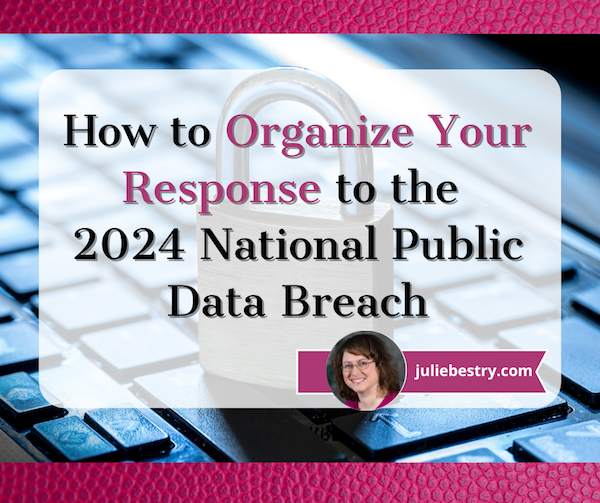
Hack! Breach! Data theft!
You see a news story about yet another company getting hacked, or you receive a letter from some service provider telling you that their servers were “breached.” Sometimes the letter offers advice, or perhaps a year of free credit monitoring.
Organizing your records, passwords, financial resources, and entire identity to protect against identity theft is exhausting. It would be understandable if you tend to tune out any news about such hacks and breaches.
Over the past week or so, however, you might have heard about a particularly nasty breach, leaving bad guys with access to millions of Social Security numbers. That probably made you sit up and take notice…and get queasy.
THE UNPRECEDENTED BREACH OF SOCIAL SECURITY NUMBERS AND MORE
At the outset, I should note that contrary to popular perception — the Social Security Administration was not hacked. The federal government wasn’t breached.

Who Got Hacked and When?
A Florida-based data brokerage company, National Public Data (NPD), got hacked. You may wonder how NPD got so much personal data in the first place. It, like many companies of its kind, scrapes data from wherever they can, including federal and state public records databases like voter registries, DMV records, professional license filings, birth/marriage/death records, criminal and civil course records, and non-public databases.
So, private information, by way of how the modern world works, gets stored somewhere over which we have no control, and then scraped, gobbled up by companies like NPD. They then turn around and sell our private data to anyone willing to pay — from employee background-check sites to private investigators (not cool, Sam Spade!) to data resellers.
According to NPD, the crime took place in December 2023; it just took a while to become known (and then a lot longer for NPD to own up to it). It’s not clear who actually stole the data.
What is clear is that the breach became known in on April 7, 2024, when a hacker group identified as USDoD posted on the dark web, offering an estimated 2.9 billion individual rows of data records for $3,5000,000. Jeez Louise!
At this point, various “bad actors” (by which I don’t mean David Hasselhoff or Pauly Shore) began posting on the dark web and leaking about the availability of the purloined data.
The breach was reported by the Daily Dark Web in a piece entitled NationalPublicData.com Hack Exposes a Nation’s Data:
The leaked data, which spans from the years 2019 to 2024, is of unprecedented magnitude, comprising 2.9 billion rows. The sheer volume of information involved is monumental, with the compressed data reaching 200GB to a staggering 4TB when uncompressed. The breached database includes comprehensive citizen information, firstname, lastname, middlename, name_suff, address,city, county name, phone 1,aka1 fullname, ssn and more. Such a massive breach raises serious concerns regarding data privacy, security, and the potential for widespread misuse or exploitation.
However, Daily Dark Web also noted that there was “a strong possibility that the assertion may be exaggerated and that the data could have been scraped from publicly available sources. Additional scrutiny and analysis are required to validate or refute these allegations.”
You’d expect that the mainstream media might attack this story like a dog with a bone, but few outlets took any notice. Instead, they focused on all the usual wars, natural disasters, sports, bird flu, Taylor Swift, and Congress trying to shut down TikTok.
Then, on July 21, 2024, someone leaked exactly what was stolen. Members of the cybercrime community Breachforums released in excess of 4 terabytes of data they claimed had been stolen (though not by them) from NPD.

Photo by Markus Spiske on Pexels.com
What Did the Hackers Get?
The breach contained massive database holdings at the nationalpublicdata.com domain, stealing Social Security records, phone numbers, physical address histories, and some email addresses of many millions of Americans. Information datasets from Canada and the United Kingdom were also included.
Per Troy Hunt, a regional director of Microsoft and founder of Have I Been Pwned (a site that helps people determine whether their email address has been included in data breaches), there were also 70 million rows from a database of U.S. criminal records.
Techcrunch referred to the data stolen as “partly legitimate — if imperfect.”
Brian Krebs of Krebs on Security further wrote that Atlas Data Privacy Corp. researchers found that there were 272 million unique Social Security Numbers in the entire records set, and that most of the records had a name, Social Security Number, and home address; approximately 26% of those records also included a phone number.
Apparently Atlas verified a subset of 5,000 addresses and phone numbers, and found that those records were, with “very few exceptions” for people born before January 1, 2002. So, maybe your college student is safe. But the rest of us? Oy.
Atlas also found that the average age of consumers in the records was 70 — with approximately two million records related to people who would be at least 120 years old at this point, so at least some of have already shuffled off this mortal coil, taking their credit lines with them.
This still leaves a lot of questions. Which data got out? Was it accurate or out of date? Which data was for deceased persons and which for real, live peeps? And what good data is paired with bad data?
If you’re feeling cyberwonky, read Troy Hunt’s Inside the “3 Billion People” National Public Data Breach. Hunt states that, “[t]here were no email addresses in the Social Security number files.” So, figuring out how bad it all is may take a while, because it’s hard to know what info is current and properly matched to your public identity.
Where Do Things Stand Now?
Mainstream media finally took notice on August 1, 2024, when California resident Christopher Hoffman filed a class action suit. Even then, NPD didn’t respond publicly until Friday, August 16, 2024, more than two weeks later, four months after the breach was originally reported, and more than eight months after the initial crime occurred!
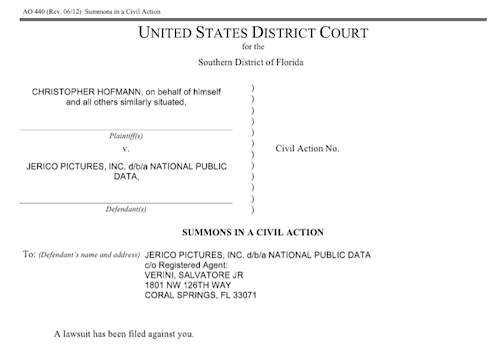
And when NPD finally did post a milquetoast-y comment, it merely said that the breach involved a “third-party bad actor that was trying to hack into data in late December 2023, with potential leaks of certain data in April 2024 and summer 2024.” Well, duh.
That’s not even all! According to two Bleeping Computer pieces, National Public Data Confirms Breach Exposing Social Security Numbers, and Hackers Leak 2.7 Billion Data Records with Social Security Numbers, on August 6, 2024, “another threat actor known as Fenice shared for free the most comprehensive variant of the database with 2.7 billion records, with multiple records referring to a single person” and further, the “threat actor known as “Fenice” leaked the most complete version of the stolen National Public Data data for free on the Breached hacking forum.”
Meanwhile, in finger-pointing worthy of the Spider-Man memes, this Fenice claimed that the data breach was actually conducted by a different threat actor named “SXUL” rather than USDoD. (What, nobody’s named Mike anymore?)
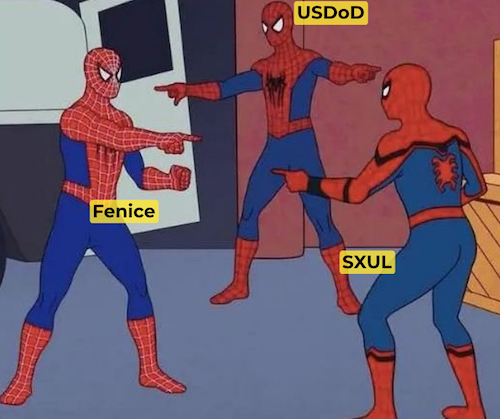
(I created this from a meme generator. Apologies for offended artistic tastes.)
So, our data was stolen, priced for sale for $3.5 million, and then offered up for free to hackers, but nobody told us regular folk until the lawyers wanted attention for a class action suit?
If you feel like you need an aspirin, you’re not alone. Nothing about this feels particularly organized. Or fair.
This class action suit is a big deal, because, as the plaintiff’s law firm explained in a press release, Hoffman was not a customer of NPD. None of us were.
Thus, unlike when we get those letters from our doctor’s office or credit card companies, we never voluntarily gave our personal information to NPD in the first place, so most Americans (and Canadians, and citizens of the UK) won’t even know if they’ve been affected by the breach until or unless something along a continuum from hinky to financially catastrophic happens.
As a result, it’s essential to take action and organize your resources against potential fallout.
HOW TO KNOW IF YOUR INFORMATION WAS HACKED
The cybersecurity firm Pentester accessed the files included in the breach and created a free database/breach check of the stolen information — but with Social Security numbers redacted, birthdates partially redacted, and phone numbers and street addresses in the clear.
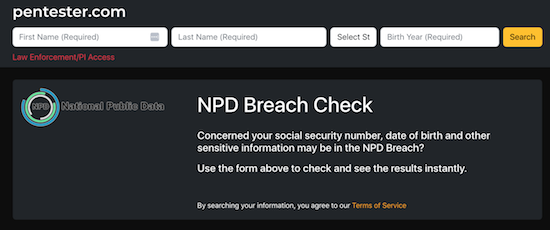
I know it doesn’t look very impressive, but experts and journalists, including at Time Magazine, have recommended using it.
Enter your first name, last name, state, and birth year. It will search billions of leaked records and note whether your information was included in the breach.
If your data isn’t found, you’ll get an error message instead of a list of records. Yay! Except that’s the starting point, not the finish line. Boo!
- Check every state you’ve lived in. Ever.
- Check your maiden name, or any other name by which you’ve been known, legally or otherwise.
- Check for your significant other, your parents, your kids, and pretty much everyone you care about. (I mean, you could also search for your horrible boss, the kid who stuffed you in a locker in seventh grade, and your ex-mother-in-law, just to enjoy a little schadenfreude. I won’t tell.)
However, will only tell you is whether your information is out there, somewhere, naked. Your next step is protect that data from molestation as best you can.
PROTECT YOURSELF AGAINST YOUR DATA BEING USED AGAINST YOU
Monitor your financial life
You should already be regularly checking your bank accounts and credit card statements for anomalies. Either log in to one at a time or use a financial dashboard like Empower, Rocket Money, or one of the other popular alternatives to the late, lamented Mint.
Next, monitor your credit reports.

Longtime Paper Doll readers know that I always advise using AnnualCreditReport.com, which, by law, guarantees a free credit report from each of the three credit reporting bureaus per year. Better yet, after the onset of the COVID pandemic and the related financial chaos that ensued, Equifax, Experian, and Trans-Union temporarily offered free weekly credit reports.
The bureaus extended those offers twice over the years, and as of last October, the Federal Trade Commission reported that AnnualCreditReport.com will now permanently make available weekly credit reports at no charge so that consumers can dispute errors, be watchful for any fraudulent account openings or changes, and report identity crimes at IdentityTheft.gov.
While you’re pulling your own credit report, pull them for your children, too. Even the existence of a credit report for a child who has never applied for credit is a big, honking sign that something fraudulent may have occurred.
Place a fraud alert on your credit file
This requires that any creditors contact you before making changes to any of the accounts you already have or before opening any new accounts in your name. You needn’t contact all three credit bureaus; rather, once you request a fraud alert with one bureau (say Equifax), the other two (Experian and Trans-Union) will be notified.
Per a law passed in 2018, fraud alerts stay in place for a full year (unless you rescind it earlier), and victims of identity theft and related crimes can secure an extended fraud alert for seven years. Previously, fraud alerts lasted only 90 days.
Also, the law requires that each of the credit reporting bureau must automatically send you a free credit report after you request a fraud alert. Scrutinize them carefully.
To request a fraud alert, contact one of the three credit bureaus’ fraud alert divisions:
- Equifax — or call 1-800-525-6285
- Experian — or call 1-888-397-3742
- TransUnion — or call 1-800-680-7289 (Note: an extended TransUnion fraud alert must be requested by mail.)
But before you choose this path, there’s a better option.
Freeze your credit file
A credit freeze is different from a fraud alert. While the fraud alert says that creditors have to contact you before changing or opening accounts, a freeze says, “Nope. Do not pass GO. Do not collect $200.” A freeze prevents any new loans or credit from being taken out in your name — even by you!
A credit freeze is different from a fraud alert. A fraud alert requires creditors contact you before changing/opening accounts; a freeze says, *Nope. Do not pass GO. Do not collect $200.* A freeze prevents any new loans/credit from… Share on XThe freeze stays in place until or unless you revoke it. So, if you need to buy a new car, seek a student loan or mortgage, or apply for a credit card, you can temporarily remove the freeze. After you secure funding, you can put the freeze back on.

Ice Photo by Enrique Zafra at Pexels.com
- Contact each of the three credit bureaus.
Unlike with the fraud alert, where you only have to contact one of the credit bureaus, you’ll need to contact all three at the following freeze division links or numbers:
-
- Equifax — or call 888-397-3742
- Experian — or call 866-478-0027
- TransUnion — or call 800-916-8800
You must create an account with login credentials before you can proceed to request a freeze.
- Keep your PINs in a safe place.
When you place a freeze on your credit, you’ll get PIN. You’ll need those PINs to defrost — I mean, unfreeze — your credit later. (Note: I helped a less tech-savvy client in her 80s accomplish this on Friday, and we learned that TransUnion no longer requires a PIN; your TransUnion login will suffice.)
Where you safeguard your PIN depends on the standard methods that you already use; you don’t want to be dependent upon your memory of an out-of-character decision.
- Write PINs down and put them in your fireproof safe or safety deposit box.
- Enter PINs in your digital password manager.
- Put PINs in your secure password book in code.
Do NOT put them on a sticky note affixed to the front of your computer. Do NOT write them in a little notebook that you take out of your home.
- Protect the credit files of your loved ones and those in your care
That 2018 law guarantees that you can freeze (and unfreeze) your own credit for free. (This is different from a credit lock, which requires a subscription to a credit bureaus’ services.) In addition to setting a freeze for yourself, you can obtain a credit freeze for your children under the age of 16. (Minors aged 16 or 17 may request their own freezes.)

Photo by Julia M Cameron on Pexels.com
Because minors can’t apply for loans, people rarely check children’s credit history. In theory, there shouldn’t even be a credit bureau file for a child, so when young adults start out trying to get student loans or credit cards, they may be in for a shock to learn that someone has already destroyed their credit!
For more on preventing children from being the victims of identity theft, check out:
https://consumer.ftc.gov/articles/how-protect-your-child-identity-theft
Additionally, if you serve as a conservator or guardian, or if you hold someone’s Power of Attorney, you may secure a free credit freeze for them, as well.
Why else should you get a credit freeze?
Any time you are at greater risk of identity theft, whether through a massive data breach, a run-in with a bad roommate, a breakup with a creep, or you’ve had your wallet stolen or your home burgled, a credit freeze can give you peace of mind that nobody will be able to access credit in your name.
Similarly, if elderly relatives develop dementia or anything that impairs their cognitive capacity, they can become prey to predatory lenders and charlatans selling everything from scammy auto repair warranties to non-existent services. A credit freeze prevents scams from moving past the spam stage.
Military Fraud Alerts
Members of all United States military branches have an additional resource that predates the 2018 law. They can set active duty alerts, allowing them to place a fraud alert for one year, renewable for the entirety of their deployment.
For Equifax, use the online form for an Active Duty Alert or call 800-525-6285. Meanwhile Experian has an online form but no phone number, and TransUnion has a phone number (800-680-7289) but no online form.
As a bonus, securing an active duty alert prompts the credit reporting agencies to remove a service member from the marketing lists for sneaky pre-screened credit card offers. (Service members can request to be added back, but who wants that junk mail?)
DON’T GET SCAMMED
Even partial information allows scammers to contact you, pretending they’re preventing scams. A caller might fake being from your bank or credit card, alerting you to a hacking risk. They may request you log into one of your accounts and change passwords (to something they provide) for “testing” purposes that might sound reasonable if you’ve been interrupted while chasing a toddler or running a meeting.
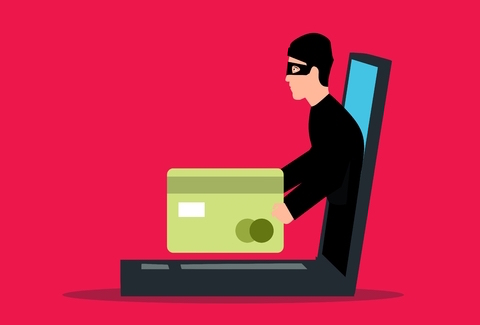
Photo by mohamed_hassan from PxHere
Be vigilant. If contacted by phone, text, or email, don’t respond, even (or especially) if the contact appears to already have some of your data. They’re using what they DO have to get you to reveal what they DON’T have — more of your private information. Call your financial institution directly.
The Social Security Administration won’t call you. They won’t email. They won’t text you. (Government sites may email or text two-factor authentication codes when you log into a federal site, like ssa.gov, but that’s initiated by you.)
My March post, Slam the Scam! Organize to Protect Against Scams, focused mainly on scams targeting seniors, but will help you protect yourself and loved ones from most common scams, and provides resources to help you learn more.
The Hill‘s August 15, 2024 piece, Was your data leaked in massive breach?: How to Know, and What to Do Now, has a good point about the likelihood of being at risk:
“If you’re a high-value individual that maybe has a high net worth or works at a company that they can extort you, you might actually be a real target,” Kyle Hanslovan, CEO of cybersecurity firm Huntress, previously told Nexstar. “For the masses though, the everyday common person, you’re more of a target of opportunity.”
Most people shouldn’t spend too much time worrying about what may happen if their information ends up in the wrong hands. Instead, Hanslovan recommends keeping an eye on your important accounts and making sure you’re prepared to act in case something does go wrong.
“It stinks for privacy, but it kind of normalizes just what’s happening,” Hanslovan said. “It doesn’t make it right, and it definitely doesn’t wave, you know, a company’s true fiduciary responsibilities to protect your data.”
Someone should tell NPD that.
Other Ways to Keep Bad Guys From Using Your Data to Hack You
- Make your passwords long and complex. Using at least 16 characters, with a mix of capitals, lowercase, numbers, and special symbols, will make it hard to hack you.

Image Source @2024 Hive Systems
- Use a password manager for all your longer, more complex passwords.
- Turn on two-factor or multifactor authentication for as many of your online accounts as allow it. (That’s like when you get a text or email with a code to enter before your login is authenticated.) Alternatively, you can use an authenticator app.
- Set up account alerts for your bank, investment, and credit card accounts, particularly to flag online or in-person purchases or ATM transactions outside of the US.
- Keep security software updated on your computer and phone.
- Don’t check financial accounts on insecure Wi-Fi networks; wait until you’re home, on secured WI-Fi network.
WHAT TO DO IF YOUR DATA IS USED FRAUDULENTLY
- File a police report.
- Report fraud to the Federal Trade Commission.
- If someone uses your Social Security number, report it at IdentityTheft.gov.
ONE LAST WEIRD THING
You may have noticed something odd about the class action suit. You’d expect National Public Data’s parent company to have a tech-leaning name, like InfoDynamics or Identidata.
Nope. The parent company is Jerico Pictures Inc., a Florida-based film studio owned by Salvatore (Sal) Verini, Jr., a retired deputy with the Broward County Sheriff’s office who fashions himself as an actor, producer, and writer.
Verini is also listed as the owner of companies called Trinity Entertainment Inc., National Criminal Data LLC, Shadowglade LLC (which sounds like a housing development in a horror movie produced by a company with a name like Jerico Pictures), and Twisted History LLC, which sounds like a joke.
Meanwhile, victims of data hacking won’t be doing a lot of laughing.
REFERENCES
As a Certified Professional Organizer®, I often help clients protect their identities and financial information. However, I am not a cybercrime specialist, nor do I play one on television. To research the specifics of this breach, in addition to the many government and tech-oriented links in the above post, I used a clarifying mainstream sources, including:
- 7 On Your Side steps to take to keep personal information safe amid latest data breach (WABC-TV)
- Hackers May Have Stolen Your Social Security Number in a Massive Breach. Here’s What to Know. (CBS News MoneyWatch)
- How to Check if Your Information Was Compromised in the Social Security Number Breach (Time Magazine)
- It’s Free to Freeze Your Credit: Here’s What You’ll Need to Do (HerMoney.com)
- The Weirdest ‘3 Billion People’ Data Breach Ever (The Verge)
- What to Know about Credit Card Freezes and Fraud Alerts (FTC.gov)
Keep your eyes open and your personal information close to the vest.









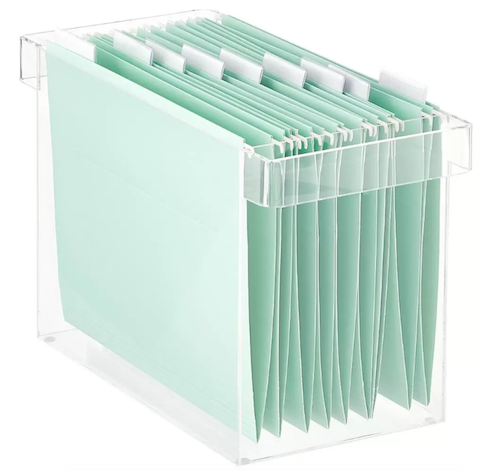
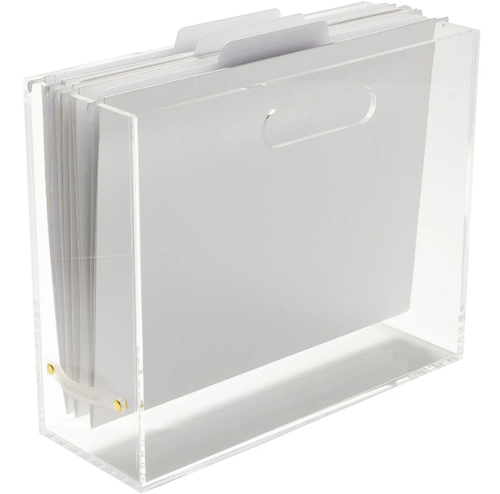

 Leather
Leather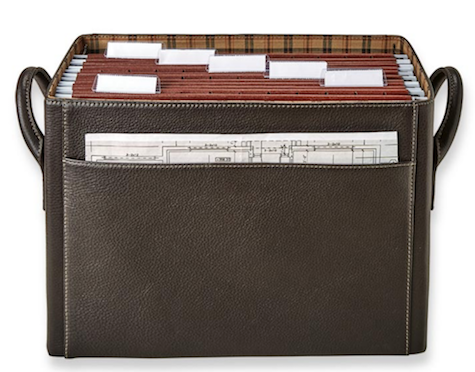
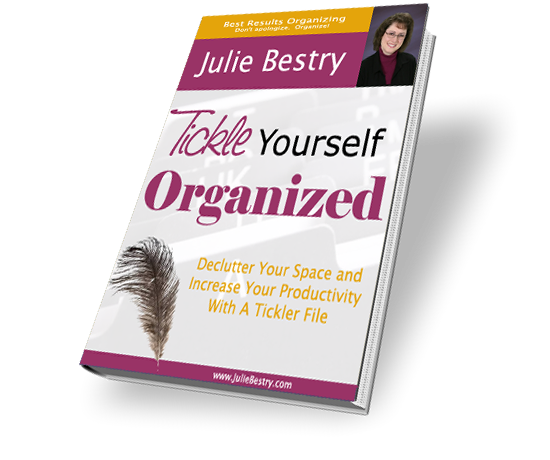


 (I’ve yet to figure out how TikTok Shop advertisers and companies like Temu and Shein can afford to price their products so low. Caveat emptor.)
(I’ve yet to figure out how TikTok Shop advertisers and companies like Temu and Shein can afford to price their products so low. Caveat emptor.)






Follow Me